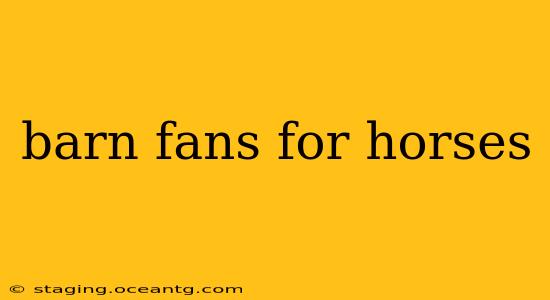Keeping your horses cool and comfortable, especially during the hot summer months, is crucial for their health and well-being. A well-ventilated barn significantly reduces the risk of heat stress, improves air quality, and contributes to a happier, healthier herd. This guide explores the importance of barn fans for horses and helps you choose the right system for your needs.
Why are Barn Fans Important for Horses?
Horses, like humans, can suffer from heat stress. High temperatures and humidity can lead to dehydration, respiratory issues, and even death in severe cases. Proper ventilation provided by barn fans is essential to:
- Reduce Temperature: Fans circulate air, creating a cooling breeze that lowers the ambient temperature within the barn.
- Improve Air Quality: Fans help remove dust, ammonia, and other airborne pollutants that can irritate horses' respiratory systems. This is particularly important for horses with pre-existing respiratory conditions like COPD (Chronic Obstructive Pulmonary Disease).
- Enhance Comfort: A comfortable environment reduces stress in horses, leading to improved behavior and overall health. They are less likely to be agitated and restless in a well-ventilated barn.
- Prevent Heat Stress: Heat stress is a serious condition that can have life-threatening consequences. Barn fans play a vital role in preventing this by lowering the temperature and improving air circulation.
What Types of Barn Fans are Available for Horses?
Several types of barn fans cater to different barn sizes and budgets:
- High-Volume, Low-Speed (HVLS) Fans: These large-diameter fans move a massive volume of air with slow rotation, creating a gentle breeze that covers a wide area. They are energy-efficient and ideal for large barns.
- Traditional Ceiling Fans: These are common and relatively inexpensive, but they often don't cover as much space as HVLS fans. They're suitable for smaller barns or individual stalls.
- Wall-Mounted Fans: These are a good option for smaller areas or to supplement other fan systems. They can be easily directed to focus airflow where needed.
- Portable Fans: These are versatile and can be easily moved around the barn as needed, offering flexibility for spot cooling.
How Many Barn Fans Do I Need?
The number of fans needed depends on several factors:
- Barn Size: Larger barns require more fans to achieve adequate ventilation.
- Ceiling Height: Higher ceilings often require more powerful fans.
- Climate: Hot and humid climates require more powerful and numerous fans.
- Number of Horses: More horses generate more heat and humidity, increasing the need for ventilation.
Consulting with a ventilation specialist or experienced equine professional can help you determine the optimal number and type of fans for your specific barn.
Where Should I Place Barn Fans?
Strategic placement of barn fans is crucial for effective air circulation. Consider these factors:
- Airflow: Place fans to create a consistent airflow pattern, ensuring that air moves through the entire barn.
- Avoid Obstructions: Ensure fans are not blocked by hay bales, equipment, or other obstacles.
- Height: Ceiling fans should be mounted high enough to provide adequate clearance and efficient air movement.
- Safety: Ensure fans are securely mounted and out of reach of horses to prevent injury.
What Size Barn Fans Should I Choose?
Choosing the right fan size is critical for achieving optimal air circulation. Consider the following:
- Cubic Feet per Minute (CFM): This measurement indicates the volume of air a fan moves per minute. Higher CFM ratings are generally better for larger barns.
- Airflow Pattern: Consider whether you need a broad, gentle breeze or a more targeted airflow.
- Horse Comfort: Observe your horses' behavior to assess whether the fan provides adequate cooling.
How Much Do Barn Fans Cost?
The cost of barn fans varies widely depending on size, type, and brand. Prices range from a few hundred dollars for smaller fans to several thousand dollars for large HVLS systems. Consider your budget and the size of your barn when selecting a fan system.
How Can I Maintain My Barn Fans?
Regular maintenance extends the lifespan of your barn fans and ensures optimal performance. This includes:
- Regular Cleaning: Remove dust and debris from fan blades and motors.
- Lubrication: Lubricate moving parts as needed.
- Safety Checks: Regularly inspect for loose parts or damage.
By following these guidelines, you can maintain a cool, comfortable, and healthy environment for your equine companions. Remember, a well-ventilated barn is an investment in the well-being of your horses.
